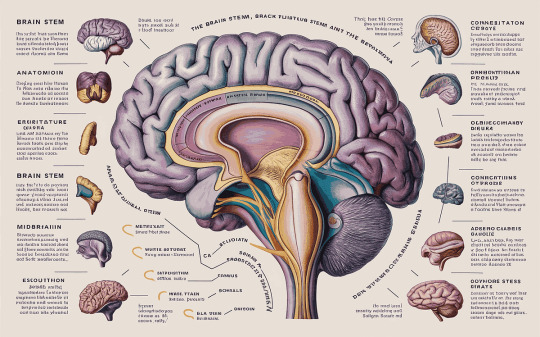#BrainStemFunction
Explore tagged Tumblr posts
Text
Function of Brain Stem

Introduction
The brain stem, often referred to as the “gateway to the brain,” is a vital component of the central nervous system responsible for regulating essential bodily functions and facilitating communication between the brain and the rest of the body. Comprising the midbrain, pons, and medulla oblongata, this intricate structure plays a crucial role in sustaining life and maintaining homeostasis.
1. Regulation of Basic Life Functions
At the core of its function, the brain stem governs fundamental physiological processes necessary for survival, including heartbeat, respiration, and blood pressure regulation. The medulla oblongata, situated at the base of the brain stem, serves as a control center for autonomic functions, such as breathing rate and heart rhythm, by monitoring sensory input and orchestrating appropriate responses.
2. Conduction Pathway for Sensory and Motor Signals
As a conduit between the brain and the spinal cord, the brain stem serves as a relay station for sensory information from the body to the brain and motor commands from the brain to the body. Nerve fibers ascend through the brain stem carrying sensory impulses towards the brain for processing, while descending fibers convey motor signals from the brain to the spinal cord, coordinating voluntary movements and reflex actions.
3. Integration of Reflexes
The brain stem plays a pivotal role in mediating reflex actions, automatic responses that occur in response to specific stimuli without conscious effort. Reflex arcs involving sensory receptors, afferent nerves, interneurons within the brain stem, and efferent nerves facilitate rapid, involuntary reactions to stimuli, such as withdrawing from pain or adjusting posture to maintain balance, ensuring swift and adaptive responses to environmental changes.
4. Control of Arousal and Consciousness
Crucially, the brain stem regulates levels of consciousness and arousal, exerting influence over wakefulness, alertness, and sleep-wake cycles. The reticular formation, a network of nuclei spanning the brain stem, modulates neural activity to promote wakefulness during periods of stimulation and facilitate transitions into sleep or altered states of consciousness, underscoring its pivotal role in regulating the overall level of cognitive awareness.
5. Coordination of Cranial Nerve Functions
Integral to its function, the brain stem houses nuclei responsible for controlling several cranial nerves involved in sensory perception, motor control, and autonomic regulation of organs in the head and neck region. By coordinating the activities of these cranial nerves, the brain stem facilitates crucial functions such as vision, hearing, facial expressions, swallowing, and maintaining cardiovascular and respiratory homeostasis.
6. Facilitation of Postural Control and Balance
Moreover, the brain stem contributes to postural control and balance through its connections with the cerebellum, a structure located at the base of the brain. By integrating sensory feedback from the body and coordinating motor commands, the brain stem helps maintain stability and equilibrium, enabling smooth and coordinated movements essential for navigating the environment safely.
7. Modulation of Autonomic Functions
Additionally, the brain stem modulates autonomic functions, regulating visceral activities such as digestion, urination, and sexual arousal through its influence on the autonomic nervous system. Sympathetic and parasympathetic pathways originating in the brain stem orchestrate physiological responses to stress, rest, and various internal and external stimuli, ensuring adaptive adjustments to maintain internal balance and respond to changing environmental demands.
8. Regulation of Cardiovascular and Respiratory Functions
Furthermore, the brain stem plays a central role in regulating cardiovascular and respiratory functions, ensuring the delivery of oxygen-rich blood to tissues and organs and maintaining optimal gas exchange in the lungs. Through specialized nuclei and reflex pathways, the brain stem modulates heart rate, blood pressure, and breathing patterns in response to physiological needs and environmental cues, safeguarding vital organ perfusion and metabolic balance.
9. Contribution to Neuroendocrine Control
Lastly, the brain stem contributes to neuroendocrine control by serving as a bridge between the nervous system and the endocrine system. Hypothalamic nuclei within the brain stem integrate neural and hormonal signals, regulating the release of pituitary hormones that govern various physiological processes, including growth, metabolism, reproduction, and stress responses, thereby exerting profound influence over systemic homeostasis and adaptation.
Conclusion
In summary, the brain stem embodies the intricate interplay between neural structures and physiological functions, serving as a linchpin of the central nervous system’s regulatory machinery. Its diverse roles encompass vital autonomic, sensory, motor, and integrative functions essential for maintaining life, consciousness, and adaptive responses to internal and external stimuli. Through its complex networks and dynamic interactions, the brain stem exemplifies the remarkable complexity and resilience of the human brain, underscoring its paramount importance in sustaining health, vitality, and cognitive function.
FAQs
1. What is the primary function of the brain stem? The brain stem is responsible for regulating essential physiological functions, including breathing, heart rate, and blood pressure, as well as controlling basic involuntary movements like swallowing and vomiting.
2. How does the brain stem connect the brain to the rest of the body? The brain stem serves as a conduit between the brain and the spinal cord, facilitating the transmission of sensory and motor signals to and from the body’s peripheral nervous system.
3. What are the major anatomical divisions of the brain stem? The brain stem comprises three main regions: the medulla oblongata, the pons, and the midbrain, each with distinct structures and functions contributing to overall neural regulation and coordination.
4. How does the brain stem contribute to consciousness and arousal? The reticular formation, a network of nuclei located throughout the brain stem, plays a critical role in regulating wakefulness, attention, and arousal levels by modulating the activity of cortical and subcortical brain regions.
5. What happens when the brain stem is damaged? Damage to the brain stem can result in profound neurological deficits, including loss of consciousness, impaired vital functions such as breathing and heart rate, and disturbances in sensory and motor control, depending on the extent and location of the injury.
10 notes
·
View notes